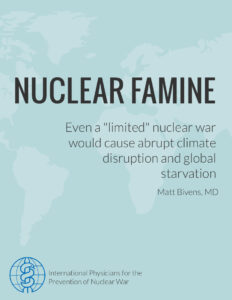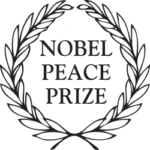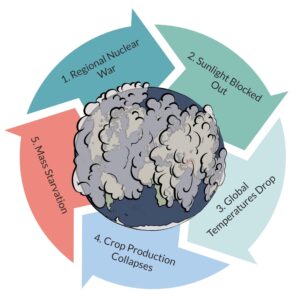A nuclear war using as few as 100 weapons anywhere in the world would disrupt the global climate and agricultural production so severely that the lives of more than two billion people would be in jeopardy from mass starvation.
A landmark report, Nuclear Famine (2022), published by IPPNW summarizes the latest scientific work which shows that a so-called “limited” or “regional” nuclear war would be neither limited nor regional. A war that detonated less than 1/20th of the world’s nuclear weapons would still crash the climate, the global food supply chains, and likely public order. Famines and unrest would kill hundreds of millions, perhaps even billions. The findings come at a time of greatly heightened tensions among nuclear states and amid warnings that we are closer to nuclear war than we have ever been.
Among the specific findings in Nuclear Famine (2022):
- Using less than 3% of the world’s nuclear weapons, a nuclear war between India and Pakistan could kill up to every 3rd person on earth, with average global temperatures dropping about 1.3 degrees Celsius.
- A full-scale nuclear war between the United States and Russia would kill an estimated 5 billion people worldwide within two years.
- The strongest caloric reductions due to abrupt cooling after a nuclear war are found over the high latitudes in the Northern Hemisphere. Nations such as Canada, Finland, Norway and Sweden are thus hit hard.
- In the case of a nuclear war, there is no possible treatment after the fact. We must focus on prevention. And the only way to ensure that nuclear weapons are never used is to eliminate them completely. The United Nations Treaty on the Prohibition of Nuclear Weapons provides the legal and moral foundation for the eradication of nuclear weapons.
- Read the full report in English, German, and Russian (additional translations pending).
 Findings in Nuclear Famine (2012):
Findings in Nuclear Famine (2012):
- Corn production in the US would decline by an average of 10% for an entire decade, with the most severe decline (20%) in year 5. Soybean production would decline by about 7%, with the most severe loss, more than 20%, in year 5.
- There would be a significant decline in middle season rice production in China. During the first 4 years, rice production would decline by an average of 21%; over the next 6 years the decline would average 10%.
- Increases in food prices would make food inaccessible to hundreds of millions of the world’s poorest. Even if agricultural markets continued to function normally, 215 million people would be added to the rolls of the malnourished over the course of a decade.
- Significant agricultural shortfalls over an extended period would almost certainly lead to panic and hoarding on an international scale, further reducing accessible food.
- The 925 million people in the world who are already chronically malnourished (with a baseline consumption of 1,750 calories or less per day), would be put at risk by a 10% decline in their food consumption.
Subsequent findings, published in 2013, paint a grim picture:
- Chinese winter wheat production would fall 50% in the first year and, averaged over the entire decade after the war, would be 31% below baseline.
- More than a billion people additional people in China would also face severe food insecurity. The total number of people threatened by nuclear-war induced famine would be well over two billion.
“The prospect of a decade of widespread hunger and intense social and economic instability in the world’s largest country has immense implications for the entire global community, as does the possibility that the huge declines in Chinese wheat production will be matched by similar declines in other wheat producing countries.,” said the report’s author, Dr. Ira Helfand.
Additional studies by IPPNW partners, including Rapidly expanding nuclear arsenals in Pakistan and India portend regional and global catastrophe (2019), show that our original prediction was based on 5 million tons of soot – it now appears there would be 15 to 35 million. This new finding indicates that there will be an even greater negative impact on global food production.
Listen to Dr. Ira Helfand outline nuclear famine:
Nuclear Famine is the second IPPNW publication to address the global health and environmental consequences of a nuclear war using only a fraction of the more than 15,000 nuclear weapons in the world today. Zero is the Only Option: Four Medical and Environmental Cases for the Eradication of Nuclear Weapons, published in 2010, describes the severe climate disruption that would result from a “limited” nuclear war, and summarizes the medical consequences of blast, heat, and radiation from nuclear explosions.
For more information about IPPNW’s work to educate the public and policy makers about the medical, environmental, and humanitarian consequences of nuclear war, contact Chuck Johnson


